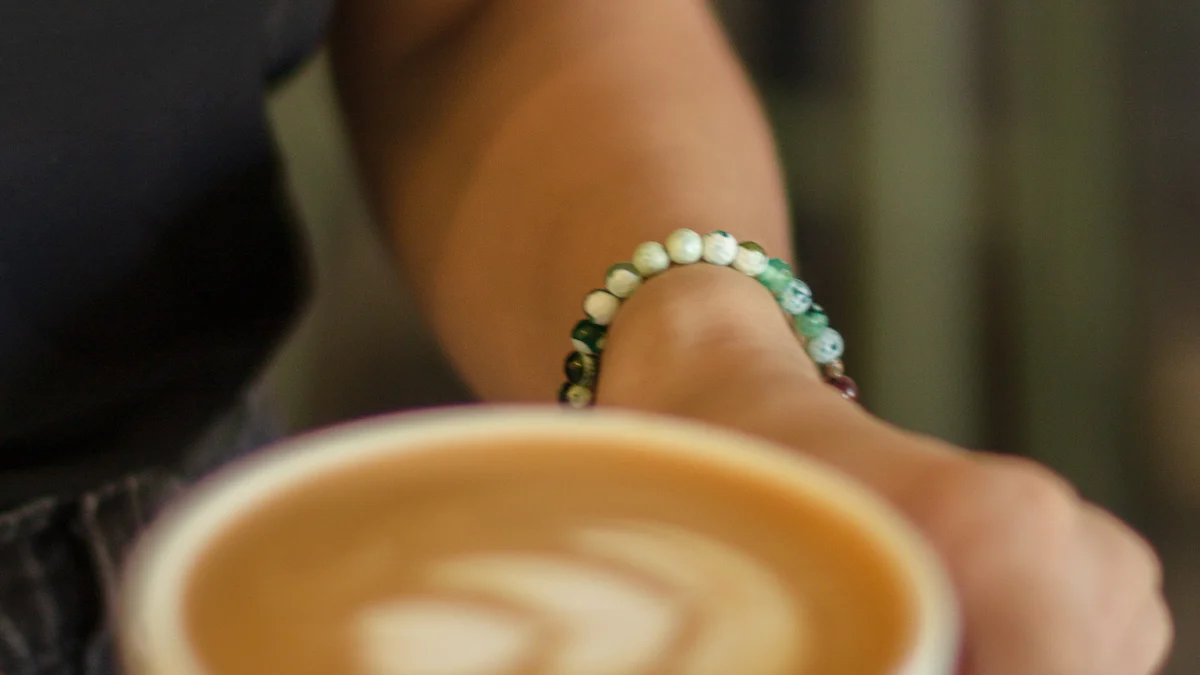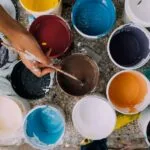FTC/ASA Disclosure: Some links in this post are affiliate links. At no additional cost to you, I will earn commission if you purchase via my links. Thank you in advance for your support! 🙏 It means a lot to me. ❤️
Latte art is the beautiful and intricate designs that baristas create on the surface of a latte or cappuccino using steamed milk. It is a combination of science and artistry, requiring skill, precision, and creativity. Latte art has become an integral part of the coffee industry, not only for its aesthetic appeal but also for the way it enhances the overall coffee-drinking experience.
The history of latte art can be traced back to the 1980s in Seattle, where it first gained popularity in the United States. It was initially introduced as a way to differentiate specialty coffee shops from regular cafes. Over time, latte art has evolved and become more sophisticated, with baristas pushing the boundaries of what is possible.
Latte art is not just about making a pretty design on top of a latte; it also serves as an indicator of the quality of the coffee and milk used. A well-executed latte art design requires a perfectly pulled espresso shot, properly steamed milk, and skilled pouring techniques. It is a testament to the barista’s expertise and attention to detail.
Key Takeaways
- Understanding the basics of latte art is essential for creating beautiful designs.
- Choosing the right milk is crucial for achieving the perfect texture and taste in your latte.
- The art of steaming milk requires proper technique and attention to detail.
- Pulling the perfect espresso shot is key to creating a strong foundation for your latte art.
- Preparing your workspace with essential tools and equipment is necessary for a successful latte art experience.
Choosing the Right Milk for Your Latte
When it comes to latte art, not all milk is created equal. The type of milk you choose can greatly impact the final result of your latte art design. The most commonly used milk for latte art is whole milk, as it has a higher fat content which helps create a creamy texture and allows for better control when pouring.
However, there are other factors to consider when choosing milk for latte art. Some people may have dietary restrictions or preferences that require them to use alternative milk options such as almond milk, soy milk, or oat milk. These alternative milks can still be used for latte art, but they may require different techniques and adjustments in order to achieve the desired texture and consistency.
When choosing milk for latte art, it is important to consider factors such as fat content, protein content, and sugar content. These factors can affect the texture, taste, and overall quality of the latte art. Experimenting with different types of milk can help you find the perfect balance for your latte art creations.
The Art of Steaming Milk: Techniques and Tips
Steaming milk is a crucial step in creating latte art. It is what gives the milk its creamy texture and allows for better control when pouring. The technique used to steam milk can vary depending on the type of milk being used.
For whole milk, the goal is to create a microfoam that is smooth and velvety in texture. This can be achieved by placing the steam wand just below the surface of the milk and slowly introducing air into it. As the milk expands, lower the steam wand deeper into the pitcher to create a whirlpool effect. This will help incorporate the air into the milk and create a creamy texture.
For alternative milks such as almond milk or soy milk, the technique may need to be adjusted. These milks have different protein structures and may require more or less air to achieve the desired texture. It is important to experiment with different techniques and adjust accordingly to find what works best for each type of milk.
Common mistakes to avoid when steaming milk include overheating the milk, creating large bubbles or foam, and not incorporating enough air into the milk. These mistakes can result in a poor texture and make it difficult to pour latte art designs.
Pulling the Perfect Espresso Shot for Your Latte
| Step | Metric | Ideal Range |
|---|---|---|
| Grind Size | Particle Size | Medium-fine |
| Dose | Amount of Coffee | 18-22 grams |
| Distribution | Evenness of Coffee | Uniform |
| Tamping | Pressure Applied | 30 pounds |
| Extraction Time | Duration of Brew | 25-30 seconds |
| Yield | Amount of Espresso | 30-40 grams |
The quality of the espresso shot is just as important as the steamed milk when it comes to latte art. A good espresso shot should have a balanced flavor, rich crema, and proper extraction time.
There are several factors that can affect the quality of an espresso shot. These include the grind size, dose, tamping pressure, and extraction time. It is important to have a consistent and precise approach to these factors in order to achieve the best results.
Tips for pulling the perfect espresso shot include using freshly roasted coffee beans, adjusting the grind size to achieve the desired extraction time, and ensuring that the espresso machine is properly calibrated. It is also important to pay attention to the dose and tamping pressure, as these can greatly impact the flavor and extraction of the espresso.
Preparing Your Workspace: Essential Tools and Equipment
In order to create latte art, it is important to have the right tools and equipment. The essential tools for latte art include an espresso machine, a steam wand, a milk pitcher, a tamper, and a thermometer.
The espresso machine is used to brew the espresso shot, while the steam wand is used to steam the milk. The milk pitcher is where the steamed milk is poured from, and it should have a spout that allows for better control when pouring. The tamper is used to evenly distribute and compress the coffee grounds in the portafilter, while the thermometer is used to monitor the temperature of the milk.
Having a clean and organized workspace is also important for latte art. This includes keeping your equipment clean and properly maintained, as well as having a designated area for preparing and pouring your latte art. A cluttered workspace can make it difficult to focus and can lead to mistakes in your latte art.
Tips for setting up your workspace for latte art include having all your tools and equipment within reach, keeping your workspace clean and organized, and having a designated area for pouring your latte art.
Pouring Techniques: Creating the Foundation for Latte Art

Pouring techniques are crucial in creating latte art designs. The way you pour the steamed milk into the espresso shot can greatly impact the final design.
There are several basic pouring techniques that are commonly used in latte art. These include the free pour, the wiggle pour, and the etching technique. The free pour involves pouring the milk directly into the espresso shot in a controlled manner, creating patterns and designs. The wiggle pour involves moving the milk pitcher back and forth while pouring, creating a wavy pattern on the surface of the latte. The etching technique involves using a tool such as a toothpick or a latte art pen to create intricate designs on the surface of the latte.
Consistency is key when it comes to pouring techniques. It is important to have a steady hand and a controlled pour in order to create clean and precise designs. Practicing different pouring techniques and experimenting with different patterns can help you develop your own unique style of latte art.
Mastering the Heart: A Classic Latte Art Design
The heart design is one of the most classic and popular latte art designs. It is a simple yet elegant design that can be easily mastered with practice.
To create a heart design, start by pouring a small amount of steamed milk into the center of the espresso shot. Then, slowly move the milk pitcher back and forth while pouring in a controlled manner. As you reach the edge of the cup, gently pull back on the milk pitcher to create a point at the top of the heart.
Common mistakes to avoid when creating a heart design include pouring too quickly, not having enough contrast between the milk and espresso, and not having a steady hand. These mistakes can result in a poorly defined heart shape or an uneven distribution of milk.
Tips for perfecting the heart design include practicing your pouring technique, adjusting your pour speed and angle, and experimenting with different milk textures. With time and practice, you will be able to create clean and consistent heart designs.
Exploring More Advanced Latte Art Designs: Tulips, Rosettas, and More
Once you have mastered the basic latte art designs, you can start exploring more advanced designs such as tulips, rosettas, and more. These designs require more skill and precision, but they can be achieved with practice and patience.
The tulip design is created by pouring a small amount of steamed milk into the center of the espresso shot, then slowly moving the milk pitcher back and forth while pouring in a controlled manner. As you reach the edge of the cup, gently pull back on the milk pitcher to create a point at the top of the tulip. Then, use a toothpick or a latte art pen to create lines or dots on top of the tulip to add detail.
The rosetta design is created by pouring a small amount of steamed milk into the center of the espresso shot, then slowly moving the milk pitcher back and forth while pouring in a controlled manner. As you reach the edge of the cup, gently wiggle the milk pitcher from side to side to create a wavy pattern on top of the latte. Then, use a toothpick or a latte art pen to create lines or dots on top of the wavy pattern to add detail.
Tips for mastering advanced latte art designs include practicing your pouring technique, experimenting with different patterns and designs, and being patient with yourself. These designs require more skill and precision, but with practice, you will be able to create beautiful and intricate latte art designs.
Troubleshooting Common Latte Art Problems
Like any art form, latte art comes with its own set of challenges and problems. Common problems encountered in latte art include poor milk texture, inconsistent pouring, and lack of contrast between the milk and espresso.
To troubleshoot these problems, it is important to identify the root cause. Poor milk texture can be caused by not incorporating enough air into the milk during the steaming process. Inconsistent pouring can be caused by not having a steady hand or not controlling the pour speed and angle. Lack of contrast between the milk and espresso can be caused by not properly layering the milk and espresso or using the wrong type of milk.
Tips for troubleshooting latte art problems include practicing your steaming and pouring techniques, adjusting your equipment and settings, and experimenting with different milk types and textures. It is also important to seek feedback from others and learn from their experiences.
Showcasing Your Latte Art: Tips for Photographing and Sharing Your Creations
Once you have created your latte art masterpiece, it is important to showcase it and share it with others. Sharing your latte art can inspire others, create connections within the coffee community, and even attract new customers to your coffee shop.
When photographing your latte art, it is important to consider lighting, composition, and focus. Natural light is often the best option for capturing the true colors and details of your latte art. Composition refers to how you frame your latte art in the photograph, while focus refers to ensuring that the latte art is sharp and in focus.
There are several platforms where you can share your latte art with others, such as social media platforms like Instagram, Facebook, and Twitter. These platforms allow you to connect with other coffee enthusiasts, baristas, and coffee shops from around the world. It is important to use relevant hashtags, engage with others in the coffee community, and be consistent in sharing your latte art creations.
In conclusion, latte art is a beautiful combination of science and artistry that has become an integral part of the coffee industry. It requires skill, precision, and creativity to create intricate designs on the surface of a latte or cappuccino using steamed milk. Choosing the right milk, mastering the art of steaming milk, pulling the perfect espresso shot, and having the essential tools and equipment are all important factors in creating latte art. Pouring techniques, mastering different designs, troubleshooting common problems, and showcasing your latte art are also crucial aspects of becoming a skilled latte artist. With practice, patience, and a passion for coffee, anyone can learn to create stunning latte art designs.
If you’re passionate about coffee and want to take your latte art skills to the next level, you might also be interested in learning about the benefits of using a manual coffee grinder. Grinding your own coffee beans can enhance the flavor and aroma of your brew, resulting in a more satisfying cup of coffee. Check out this article on BrewHilda.com to discover the advantages of using a manual coffee grinder and how it can elevate your coffee experience. (source)
Brewhilda.com is a participant in the Amazon Services LLC Associates Program, an affiliate advertising program designed to provide a means for sites to earn advertising fees by advertising and linking to Amazon.com.










